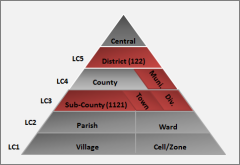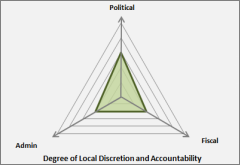 Country Profile Background
Country Profile Background
Uganda embarked on an ambitious decentralization program in the early 1990s under President Museveni after emerging from a series of dictatorial regimes and civil wars. In order to achieve greater empowerment and a more responsive public sector, Uganda’s 1995 Constitution provided for an extensive system of local government. Further reforms, following the 1997 Local Government Act, transferred considerable responsibility for public service delivery to the district level. While the initial years of decentralization generally resulted in a greater participation, the concomitant improvement in local public services proved disappointing as local governments confronted a wide range of challenges, including a lack of capable staff, elite capture and corruption. Since 2005, the tendency in Uganda seems to be one of re-centralization of powers and authority, as central government has become more assertive over local affairs, while the administrative powers and financial resources of local governments have been gradually eroded.
 Organizational/Governance Structure of the Public Sector
Organizational/Governance Structure of the Public Sector
Uganda territorial governance structure recognizes five levels of Local Councils (LCs) below the national level. The lowest level is the Local Council I (LC 1), which is responsible for a village (or in the case of towns or cities, a neighborhood). The highest level is the Local Council V (LC5), which is responsible for the entire district. Intermediate subdivisions in rural areas include the Parish (LC2), Sub-County (LC3) and County (LC4). Urban areas have a somewhat different territorial governance structure (including City, Municipality and Town Councils) in a structure that generally mirrors the rural system. An important legal distinction should be made between Local Government Councils (corporate bodies empowered by the Local Government Act of 1997 where the council is the highest political authority in its area of jurisdiction) and Administrative Unit Councils (where councils serve as political units to advise on planning and implementation of local services). For instance, in rural areas, only the District Council and the Sub-County are Local Government Councils.
In addition to the vertical fragmentation of the local government system, the structure of local governments in Uganda has become considerably more fragmented at the district level over the past twenty years as well: the number of districts in the country has increased from 39 districts in 1995 (the year in which the Constitution was adopted) to 111 districts (plus Kampala City) in 2010.
 Functional Responsibilities of the Local Public Sector
Functional Responsibilities of the Local Public Sector
The Local Governments Act 1997 lists the broad functions to be carried out by the districts, including (primary and secondary) education, health services, water, roads, agricultural extension, community affairs, and so on. Urban councils are assigned additional functions, such as street lighting, slaughterhouses, public sanitation and other urban services. Furthermore, the Local Government Act specifies that numerous functions and services have to be devolved onward by district councils to lower local government councils (i.e., the Sub-County level in rural areas). In practice, however, the district level retains the bulk of service delivery responsibility over local services, with little or no autonomy or discretion at the Sub-Country level over the delivery of services. Furthermore, despite the de jure assignment of many important functions to the local level, central line ministries often continue to be extensively involved in different aspects of local service delivery, including infrastructure development.
 Fiscal Profile of the Public Sector
Fiscal Profile of the Public Sector
Despite Uganda’s record as ‘darling’ among donor agencies for their initial decentralization efforts, the Fiscal Profile shows a rather centralized picture. Local governments are largely funded from earmarked grants and have only limited access to own source revenues. Although local governments at the district level plan, adopt and manage their own budgets, district-level local government budgets (including grant-funded expenditures as well as own-source funded expenditures) are incorporated in the national budget, with each district having their own budget vote in the national budget. Local government wage expenditures for local-level public servants are paid directly by the national treasury into the bank accounts of the local government staff (rather than throuhg council accounts).
Only 19.7 percent of total public sector expenditures in Uganda are channeled through Local Councils to finance the extensive service delivery responsibilities assigned to the local level. In addition, 11.3 percent of public sector expenditures is directed towards the delivery of local public services by central line ministries. As such, in total, the local public sector accounts for 31 percent of total public spending. In contrast, the central government retains 69 percent of public sector resources at the central level for the funding of central government administration and national functions (such as national defense, national highways, and so on).
 Institutional Profile of the Local Public Sector
Institutional Profile of the Local Public Sector
Despite a constitutional framework defining a strong, devolved local government system, there is a considerable gap between the de jure status of local governments in Uganda and the de facto degree to which Local Council are able to control local affairs. Although local governments at the district level are corporate bodies with their own political leadership, their ability to plan and manage their own affairs is limited. For instance, on the administrative front, constitutional reforms in 2005 eliminated the right of Local Councils to appoint their own Chief Administrative Officers. On the fiscal front, the ability of Local Councils to deliver the services and functions assigned to them has eroded over time. Although the Constitution prescribes specific grants to be provided to the local level, the share of public sector resources being transferred to Local Councils has declined over time, with central line ministries increasingly clinging to available financial resources. At the same, central government has reduced the ability of Local Councils to collect own source revenues.
Country Profile Information
Complete LPS Country Profile: Uganda (PDF)
Complete LPS Country Profile: Uganda (XLS)





